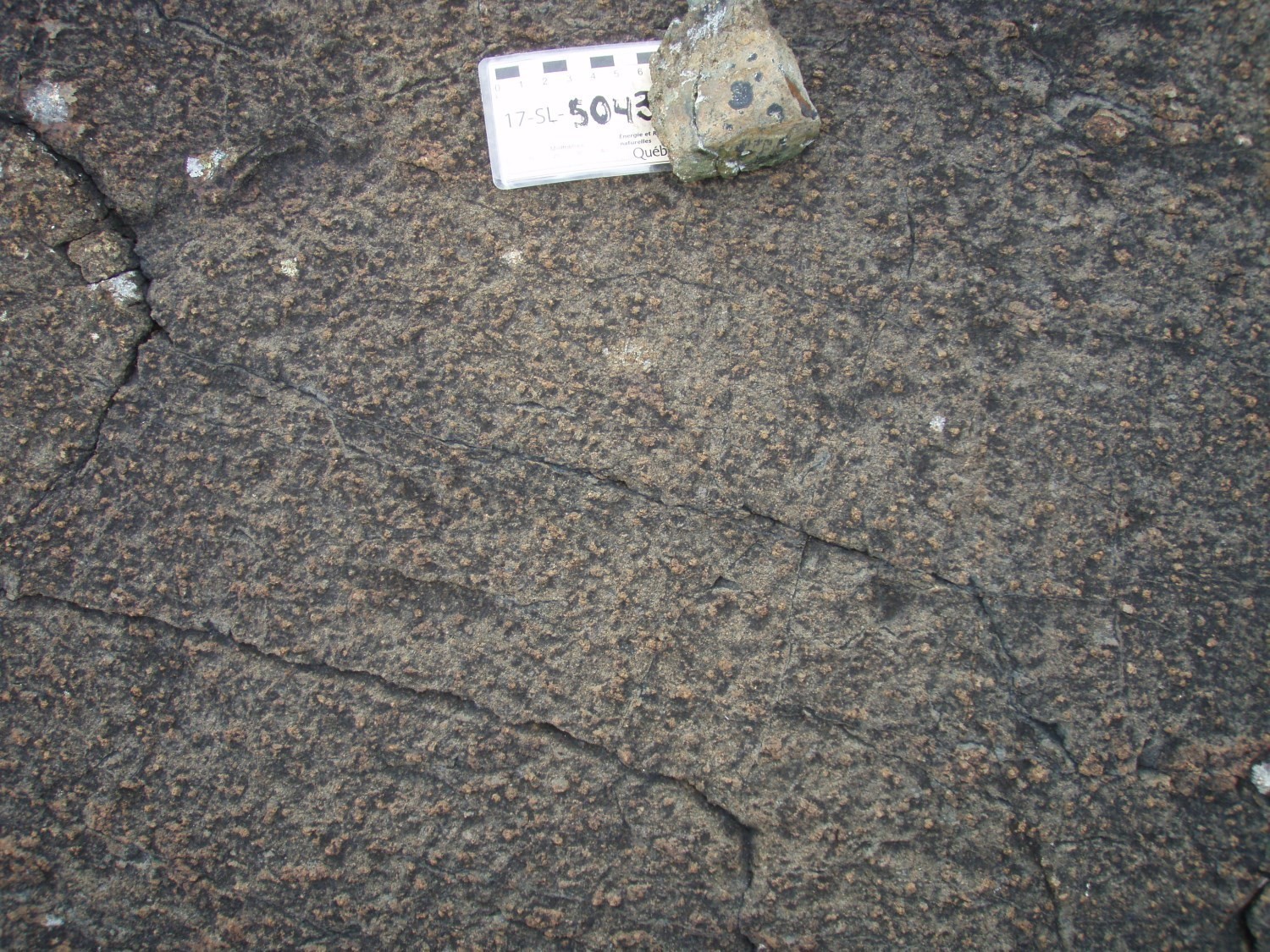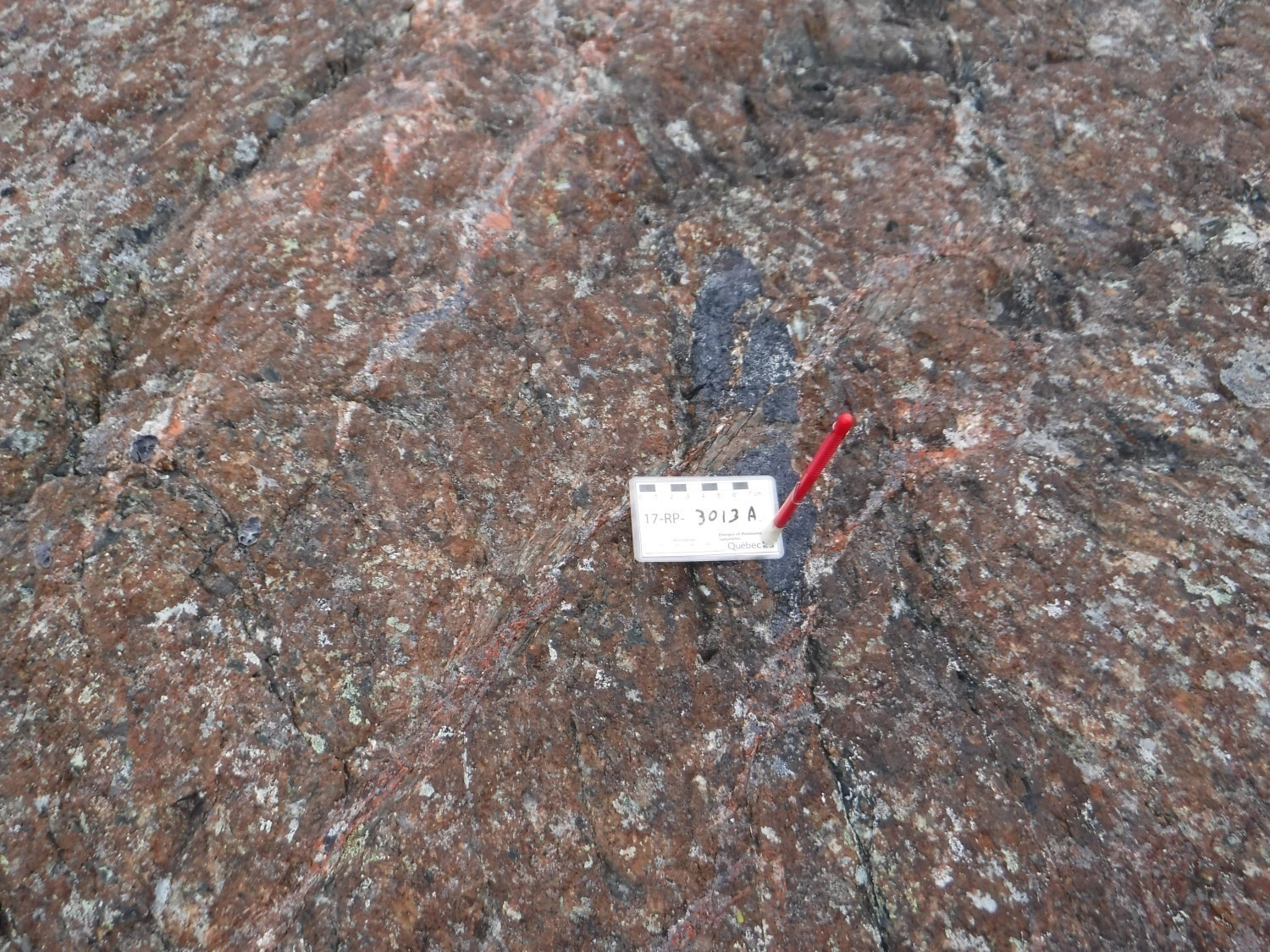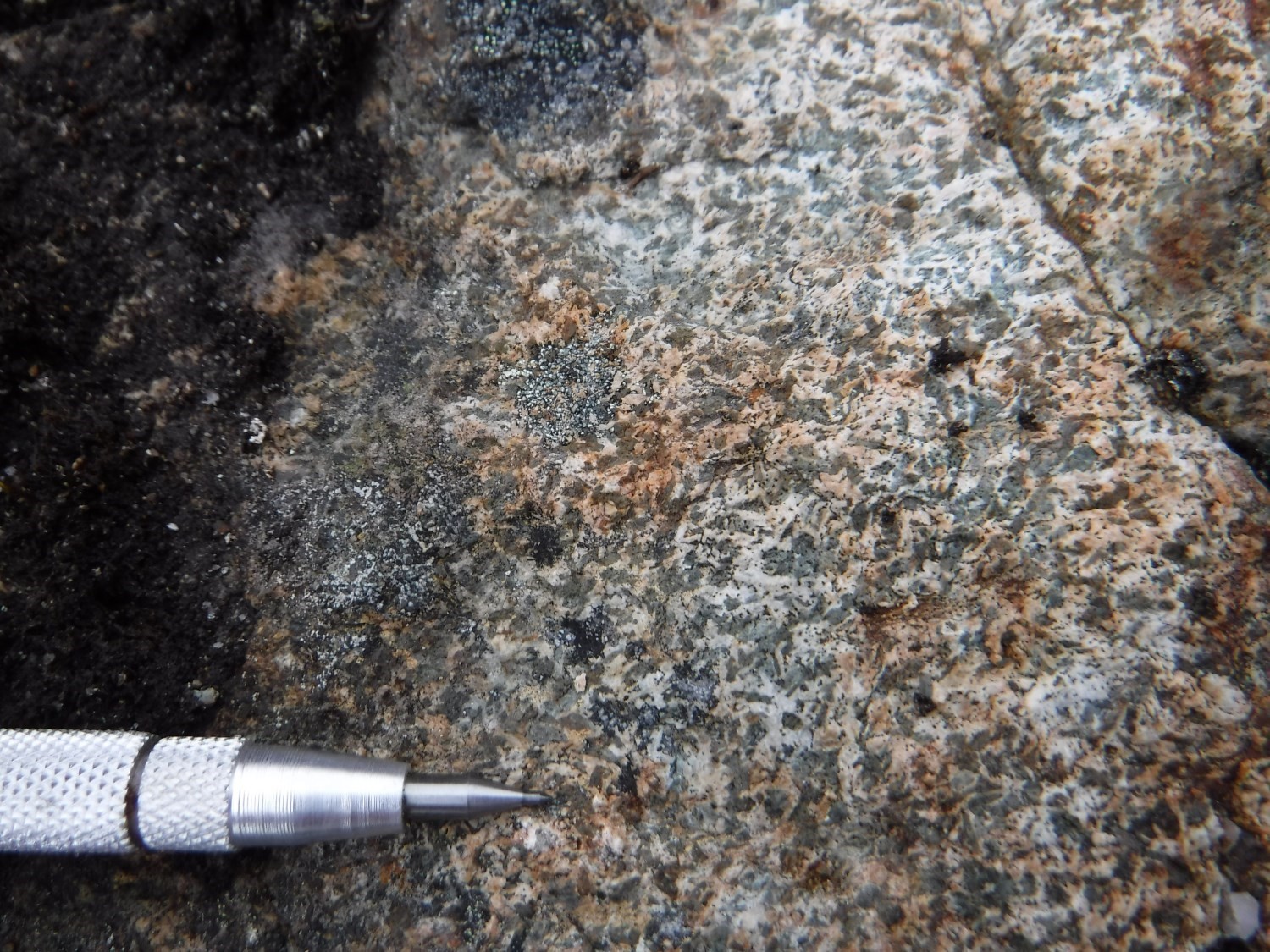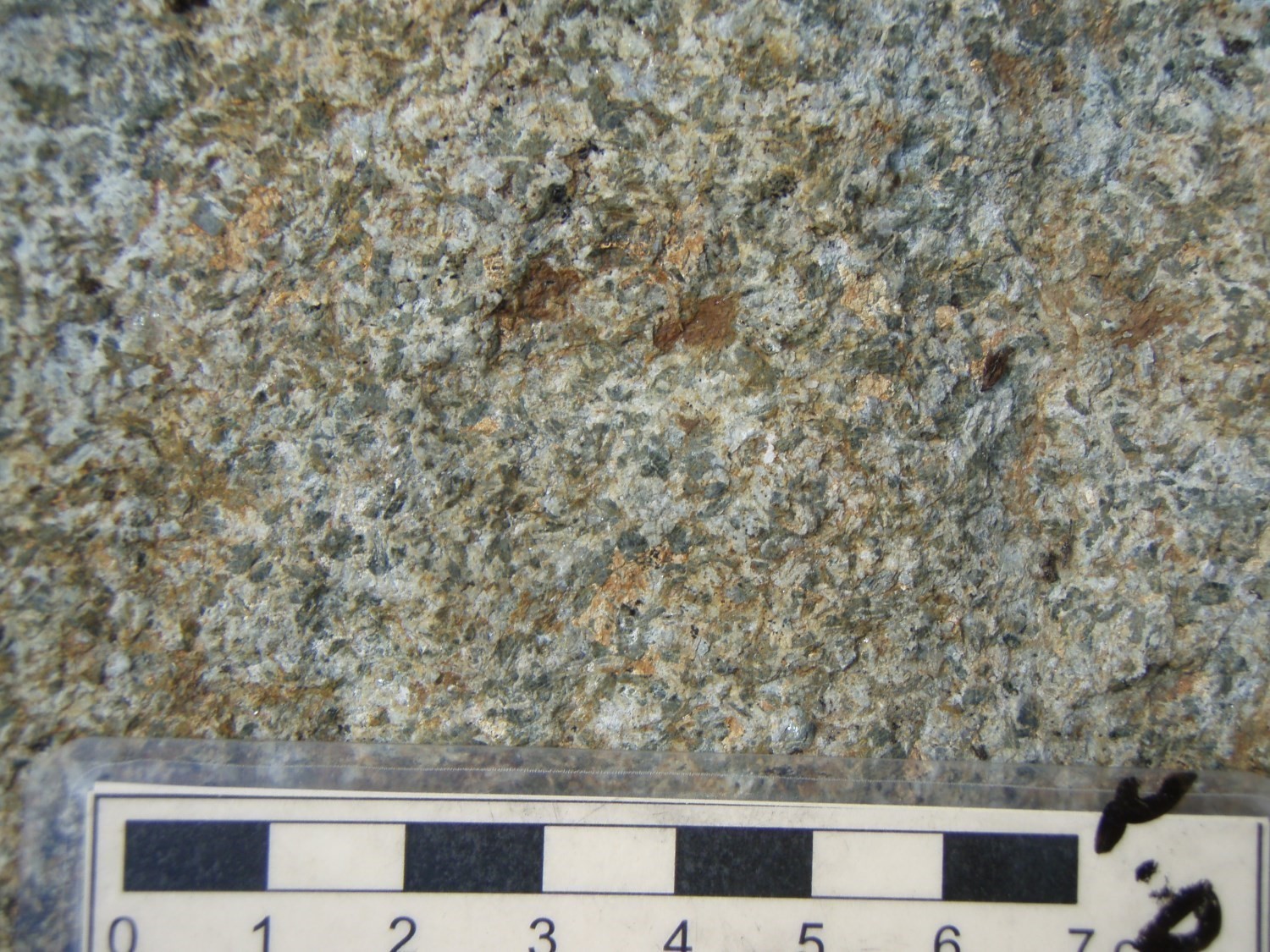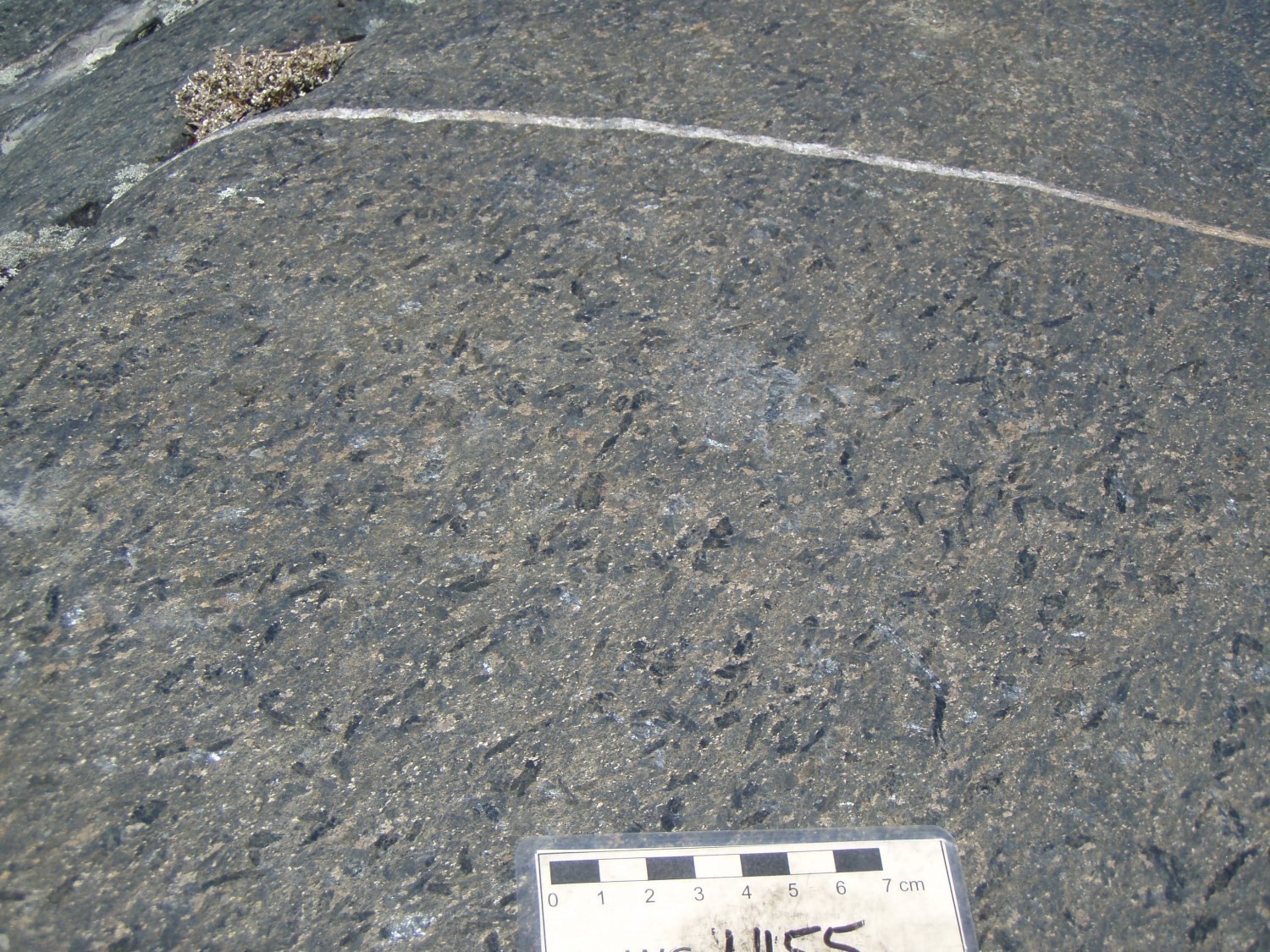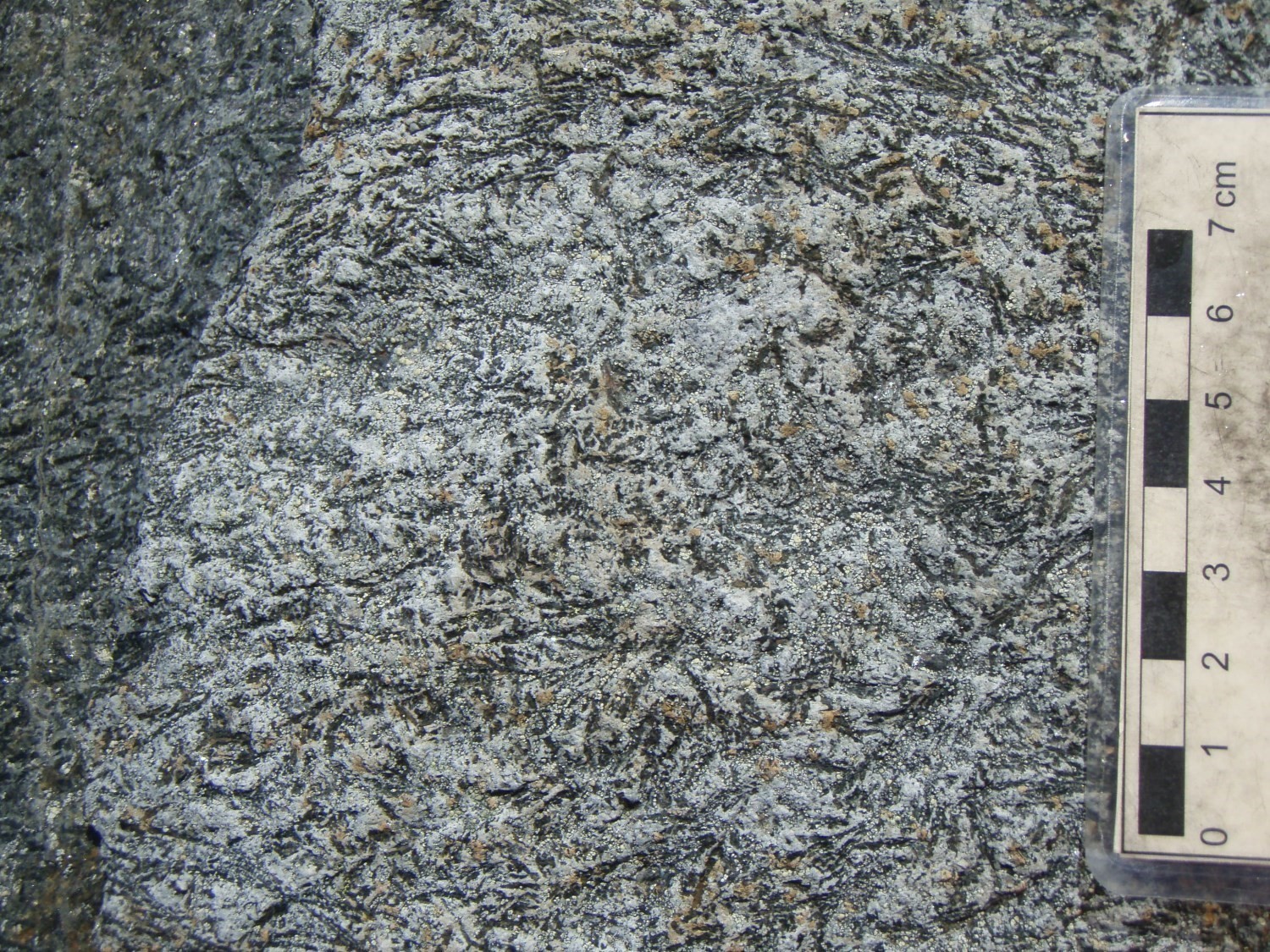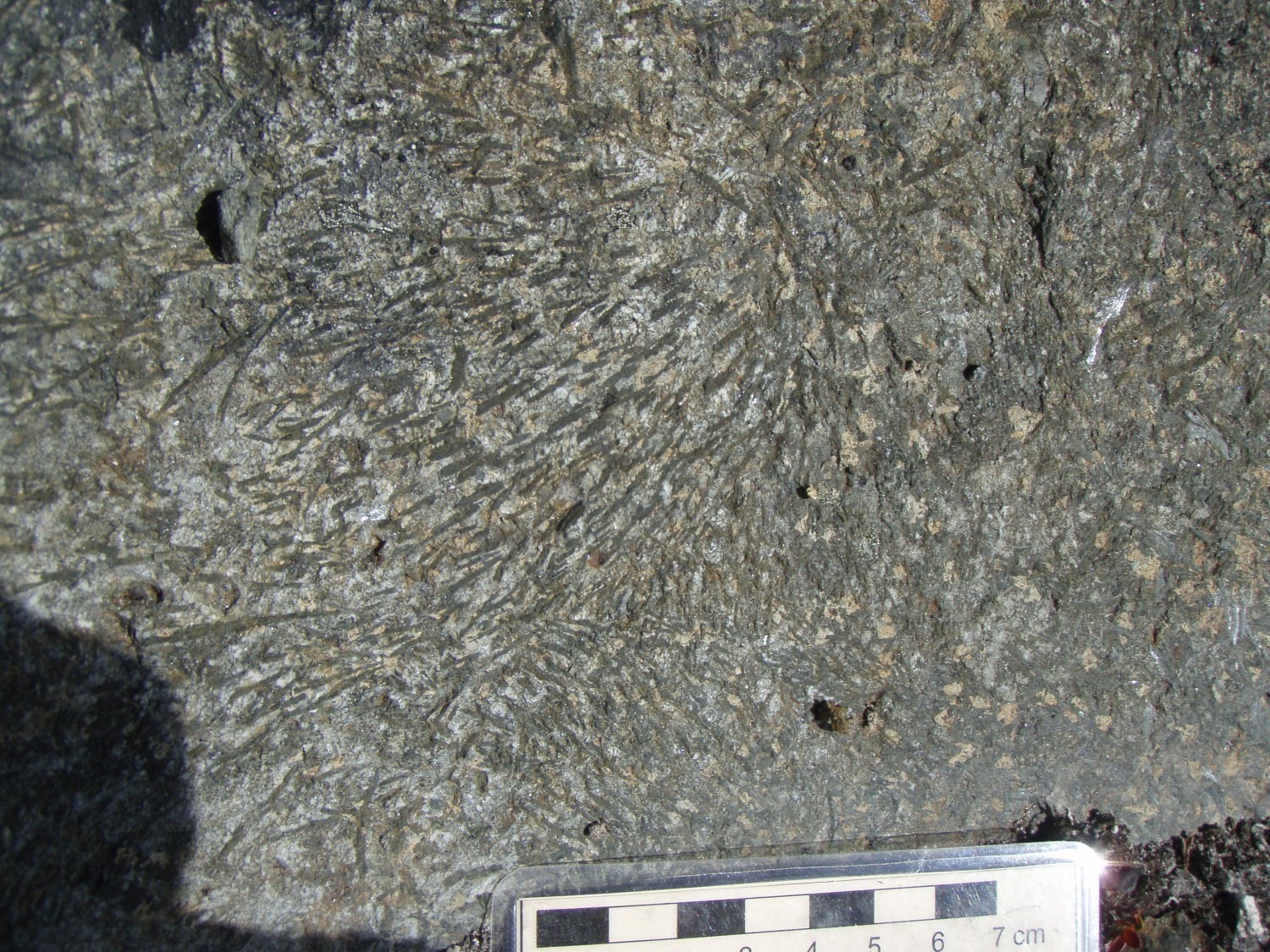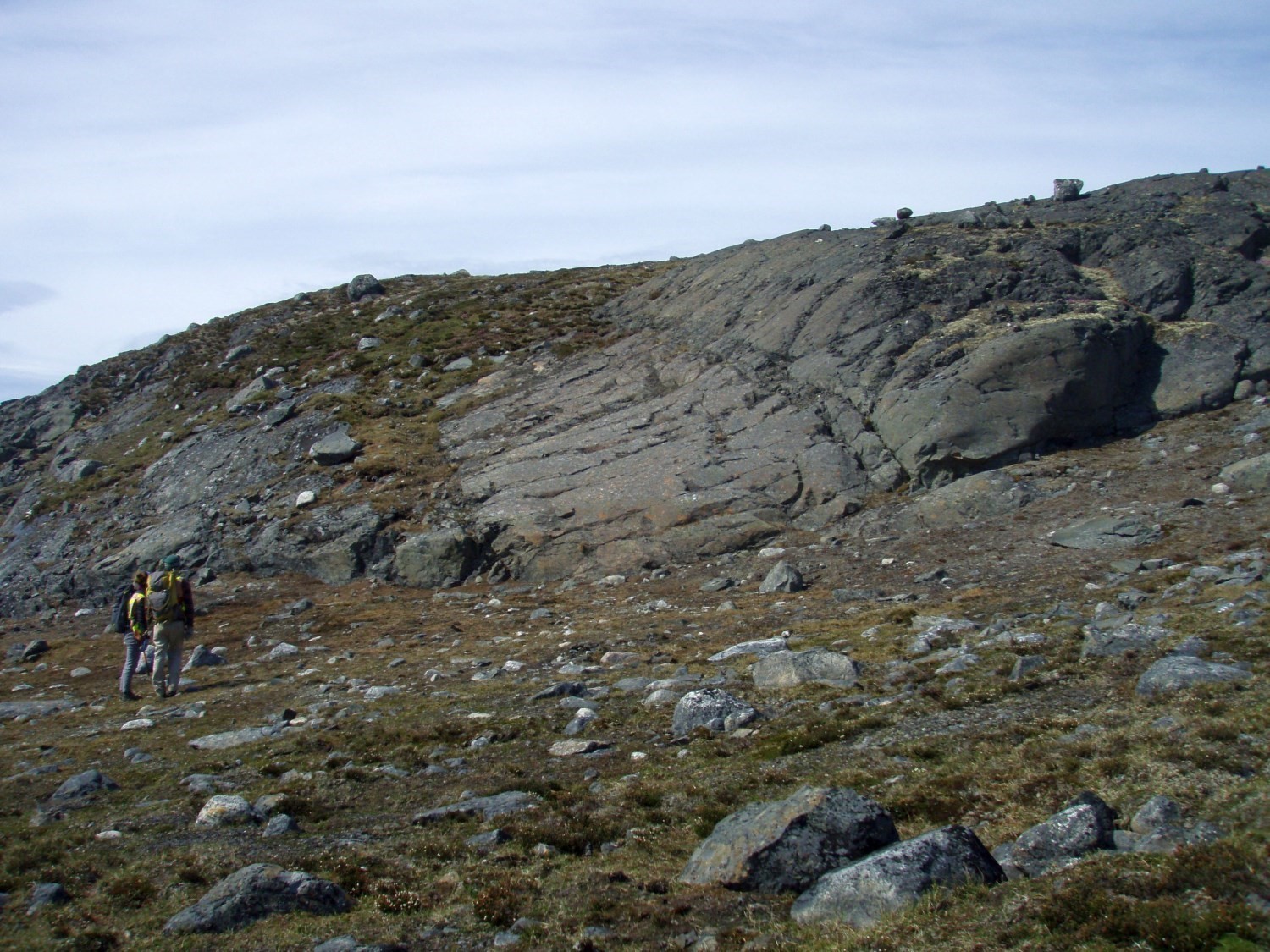
DISCLAIMER: This English version is translated from the original French. In case of any discrepancy, the French version shall prevail.
| Author(s): | Bilodeau and Caron-Côté, 2018 |
| Age: | Paleoproterozoic |
| Stratotype: | None |
| Type area: | Retty Lake area (NTS sheet 23O08) |
| Geological province: | Churchill Province |
| Geological subdivision: | New Quebec Orogen (Labrador Trough) / Cambrien, Gérido, Howse, Hurst, Payne, Retty, Schefferville and Wheeler lithotectonic zones |
| Lithology: | Mafic to ultramafic intrusive rocks |
| Category: | Lithodemic |
| Rank: | Suite |
| Status: | Formal |
| Use: | Active |
- Montagnais Supersuite
-
- Gerido Intrusive Suite
- Wakuach Suite
Background
The Gerido Intrusive Suite was introduced by Bilodeau and Caron-Côté (2018) to group all sills intruding into rocks of the Labrador Trough’s second volcano-sedimentary cycle (Koksoak, Le Moyne and Doublet groups). The Gerido Intrusive Suite replaces part of the Montagnais Sills unit. The other part, consisting of mafic sills intruding into the Labrador Trough’s first volcano-sedimentary cycle rocks (Seward, Pistolet, Swampy Bay and Attikamagen groups), was assigned to the Wakuach Intrusive Suite.
The term “Montagnais Intrusives” was introduced by the Labrador Mining and Exploration Company (1949) to refer to all intrusive rocks in the Kaniapiskau Supergroup (Frarey and Duffell, 1964). The name “Montagnais Group” was then formalized by Frarey and Duffell (1964) and Baragar (1967) to group all gabbroic and ultramafic rocks of the Labrador Trough. Frarey and Duffell (1964) then included “Walsh Intrusives” (abandoned) of the Labrador Mining and Exploration Company (1949), considered equivalent, in the Montagnais Group. These authors also subdivided the Montagnais Group into two units which they elevated to the rank of formation. The name “Retty Peridotites” was proposed for a large set of ultramafic sills near Retty Lake, while the name “Wakuach Gabbro” was proposed for the majority of gabbroic intrusions observed in the Wakuach Lake area (Frarey and Duffell, 1964). Note that the term “Montagnais Group” has no stratigraphic value. It is used in literature as a practical catch-all that groups all gabbroic and ultramafic rocks of the Labrador Trough, regardless of age and origin (Dimroth, 1978; Dressler, 1979). In accordance with the North American Stratigraphic Code, Goutier and Wares (1989) reclassified the mafic-ultramafic sills under the general name “Montagnais Sills” since the word “group” cannot be used for a series of intrusive rocks. The Qarqasiaq Complex in the Kangirsuk region has been integrated into the pPgrd1 unit of the Gerido Intrusive Suite.
Description
The Gerido Intrusive Suite is a lithodemic unit containing almost all of the mafic and ultramafic intrusions into the supracrustal units of the second volcano-sedimentary cycle of the Labrador Trough. This unit does not take into account the age or origin of intrusive rocks. Similar lithologies are present in the Hellancourt Formation (pPhe) and the Baie Kyak Intrusion (pPkya) in the Kangirsuk region, but are not included in the Gerido Intrusive Suite. There are two main types of intrusions, differentiated mafic sills (pPgrd2) and ultramafic sills (pPgrd1). Part of the differentiated mafic sills include both mafic and ultramafic compositions. Based on compositional and structural variations, many facies have been defined by the mafic sill unit (pPgrd2), such as glomerophyric gabbro and porphyritic gabbro (pPgrd3), ferrogabbro (pPgrd4), quartz gabbro, quartz diorite and granophyry (pPgrd5), amphibolitized gabbro (pPgrd7), felsic porphyry and rhyolite (pPgrd8), hornblendite (pPgrd9), melanocratic gabbro (pPgrd10), diorite and leucocratic gabbro (pPgrd 11), ultramafic rock (pPgrd12) and monzogabbro (pPgrd14).
Interpretations indicate that these intrusions are part of the same magmatic series of tholeiitic affinity resulting from partial melting of a depleted mantle (Bédard, 2017). For Hellancourt Formation gabbros, their petrography and composition are so similar to those of the host basalts that it is preferable to treat them as an intrusive-extrusive cogenetic complex, whereas volcanic rock-associated gabbros are possibly coarse-grained basaltic flows for some. With the exception of ultramafic ones, intrusions show very low levels of crustal contamination, and the latter appears to be more significant at the edge (Bédard, 2017). No gabbro is entirely fresh, most containing few primary minerals. Textures are relatively well-preserved except in more metamorphosed locations (Dimroth, 1978).
Gerido Intrusive Suite 1 (pPgrd1): Peridotite, Pyroxenite, Serpentinite and Metamorphosed Ultramafic Rocks
Unit pPgrd1 consists of ultramafic sills intruding into the Gerido gabbros (pPgrd2). They consist of peridotite, pyroxenite, serpentinite and metamorphosed ultramafic rocks. Some of these ultramafic rocks are part of differenciated and bedded mafic to ultramafic intrusions of the Bay aux Feuilles (Bédard, 2017) and Bleu Lake (Laurent, 1995) region. In the Kangirsuk region, ultramafic rocks are in sharp and intrusive contact with gabbros (pPgrd2 unit) and are mostly present at the gabbro lower contact. Some of the ultramafic rocks had been assigned to the Qarqasiaq Complex, introduced by Hardy (1976) to group ultramafic lava and associated subvolcanic intrusions. No specific geochemical structure or signature supports the conclusion that there are ultramafic volcanic rocks in this region. Rocks of the Qarqasiaq Complex were therefore assigned to the pPgrd1 unit.
Pyroxenite has been observed in the median portion of the gabbroic sill (Hardy 1976), but there is no apparent evidence of magmatic differentiation (e.g., accumulation of crystals by gravity, magmatic bedding, or progressive or rhythmic contacts). Dykes are in places branched into their sommital part, as observed in the sill of the Qarqasiaq Lake area, but multiple ultramafic intrusions have not been recognized. The sill of the Chaunet Lake area is unique for its serpentinite composition without a relic of olivine or other ferromagnesian minerals, with the exception of a few samples. From base to top, pyroxene and plagioclase increase in favour of serpentine (Hardy, 1976). The centre of the sill is pyroxenite with gradual contact with the upper part of the gabbro (pPgrd2). Contacts between gabbro and pyroxenite are gradual and could represent an equivalent of the differentiated mafic to ultramafic sills recognized in the Bay aux Feuilles (Bédard, 2017) and Bleu Lake (Laurent, 1995) region.
Although rocks are characterized by variable magnetic susceptibility, the unit is easily identifiable by a strong positive aeromagnetic anomaly. Ultramafic rock outcrops in the area are identifiable by the rounded terrain they form and their typical altered surface of massive, rough and fractured appearance. Their patina is usually brownish red and the fresh surface is greenish black. Rocks are not deformed anywhere.
Unit composition varies from sector to sector. It consists of olivine and oikocrystic hypersthene websterite in the Bay aux Feuilles region, in the north-central Labrador Trough (Bédard, 2017), and highly altered peridotite in the Kangirsuk region, where mineralogy and primary textures are almost completely obliterated by alteration and metamorphism. Rocks are generally massive, homogeneous, fine to medium grained, rarely medium to coarse grained, heterogeneous or porphyritic (crystals >1 cm). The unit is also characterized by an abundance of olivine or pyroxene pseudomorphs and the oikocrystic texture of some minerals.
In outcrops, the composition of the rock is characterized by large, homogeneously distributed, greenish-grey crystals interpreted as uralitized pyroxenes. In microscopy, up to 80 % fractured and highly serpentinized olivines are observed, round and joints for the most part. Olivine cores are preserved in few samples, most of which are replaced by antigorite and talc. Interstices consist of orthopyroxene crystals replaced by colourless amphibole (interpreted as tremolite) and a serpentine-chlorite-talc assemblage, as well as fine-grained crystals of clinopyroxene, orthopyroxene, hornblende, magnetite and spinel. Some samples contain up to 15 % oxides distributed with carbonates on the rim of olivine crystals and inside their fractures. Magnetite and pyrrhotite are ubiquitous and, locally, form small clusters. The intensity of serpentinisation is variable and always accompanied by centimetric to decimetric veins with no preferential orientation and fibrous and drusy serpentine stockwerks, often lined with a magnetite border. Veins only cut ultramafic rocks or gabbros that may contain olivine (pPgrd2).
Gerido Intrusive Suite 2 (pPgrd2): Aphyric Mesogabbro, Olivine Gabbro and Differentiated and Bedded Mafic Intrusion
The pPgrd2 unit groups aphyric gabbro sills and differentiated gabbros. Rocks consist of uralitized gabbronorite of little varied composition and structure, which is generally mesocratic, ophitic to subophitic, massive and bedded. Gabbros are predominantly intrusive into the volcanic sequence. They are divided into two groups, thin dykes and thick dykes. Thin dykes have very uniform mineralogy from the base to the top. There are two varieties of thick dykes: 1) those characterized by a gradual transition to the ferruginous gabbro unit (pPgrd4), or to horizons of quartz diorite, granophyres or pegmatitic gabbro (pPgrd5); and 2) those whose summits contain no facies of units pPgrd4 and pPgrd5 (Sauvé and Bergeron, 1965). Differentiated mafic intrusions have the following characteristics: 1) gradual variation in the primary minerals’ chemical composition from the base to the top of the dykes and development of new minerals; 2) presence of feldspar enclaves or millimetric to centimetric streaks conformable to bedding; 3) presence of veins, dykes and clusters of pegmatitic gabbro or felsic material in the middle and upper parts of the dykes; 4) presence of diabase (with chilled margin) cutting the gabbro (without chilled margin) and non-parallel sinuous walls; and 5) presence of quartz-feldspar breccia and granophyre observed very locally. Quartz diorite and granophyre are formed from the differentiation of a basaltic magma (Sauvé & Bergeron, 1965). According to Baragar (1967), the gradual shift from melanocratic gabbro to leucocratic metagabbro is not the result of normal magmatic differentiation, but rather a change in composition.
The aphyric gabbro unit (pPgrd2) represents the Gerido Intrusive Suite’s dominant facies in all parts of the Labrador Trough. Its identification is based on the recognition of textures that characterize the unit and make it possible to distinguish it from gabbro sills of other units, particularly those attributed to the Hellancourt Formation (pPhe and pPhe5). In the Kangirsuk region, the pPgrd2 unit usually consists of gabbronorite with a compositional bedding of magmatic origin. The unit does not contain ultramafic differentiated horizons as recognized in the southern and north-central parts of the Labrador Trough (Bédard, 2017; Laurent, 1995). Gabbro shows very little textural variation and almost complete preservation despite metamorphism affecting many sills. It is generally massive, fine to medium grained, rarely made of crystals greater than 5 mm. The unit is mesocratic, ophitic or subophitic, a texture that is marked by the distribution of non-joint plagioclase laths or intergrown amphiboles. Rocks are locally coarse grained and without any particular texture, leucocratic to mesocratic or mesocratic to melanocratic, trachytic with a preferential orientation of plagioclase or with a speckled (spotted) texture such as that of the Hellancourt Formation gabbro (pPhe5). Rocks typically are light green, dark green or black in altered patina and dark green to brownish in fresh exposure, similar to the host chlorite basalt (pPhe). The presence of serpentine veinlets in some gabbros near ultramafic intrusions strongly suggests the presence of olivine in these rocks.
The gabbro mineralogy in the north-central part of the Labrador Trough (Kuujjuaq region) consists of 40-60% plagioclase-epidote assemblage, and 35-55% amphibole-chlorite assemblage. Accessory minerals are apatite, titanomagnetite and leucoxene. Rocks may contain pyrite and pyrrhotite associated with quartz and chlorite (Sauvé and Bergeron, 1965). Plagioclase is replaced by clinozoisite and albite, and pyroxene is replaced by actinolite and chlorite. Actinolite is generally coarser (≤3 mm) than plagioclase (≤1 mm). It is poikilitic in the lower part of sills in this area (Sauvé and Bergeron, 1965). Several gabbro horizons contain olivine and up to 1% interstitial blue quartz towards the top of the sills (Sauvé and Bergeron, 1965). In the Kangirsuk region, gabbros all have the peculiarity of being strongly uralitized, as evidenced by light pyroxenes replaced by amphibole, which is clearly visible in alteration patina. These gabbros could have been grouped into the amphibolitized gabbro unit (pPgrd7), but recognition of their primary textures justifies their affiliation to the pPgrd2 unit.
Gabbros vary in composition as there is magmatic bedding. Rocks contain between 40 and 70 % large crystals of colourless to light green amphibole (actinolite-tremolite phase) forming isolated prisms up to 1 cm long, usually joint and locally twinned. Amphibole is thick, rarely poikilitic, cleavage-free, with plagioclase lath inclusions and fibrous and acicular ends. Preservation of some pyroxene cores suggests almost complete metamorphic replacement of pyroxene. Rocks also contain between 30 and 60 % tabular or lath plagioclase weakly to strongly replaced by epidote (zoisite and clinozoisite varieties), which is predominantly present in the cores and in contact with plagioclase. Alteration of the latter to muscovite is generally weak.
Amphibole crystals or clusters are hosted in a matrix of large plagioclase crystals completely replaced by very fine-grained epidote. Interstitial space is also occupied by fine-grained plagioclase laths and amphibole crystals (actinolite-tremolite) or amphibolitized clinopyroxene. The speckled (spotted) texture facies features amphiboles rimmed with small clusters of random plagioclase laths cutting the rim of crystals. Secondary minerals are dominated by epidote, particularly around amphibole and plagioclase, quartz, chlorite and possibly sericite clusters, as well as up to 10 % medium-grained, stocky titanite (or leucoxene), twinned in places and homogeneously distributed. Gerido Intrusive Suite gabbros’s titanite has the peculiarity of being formed of small clusters of radial-shaped crystals that replace almost all other phases, probably titaniferous. Opaque minerals are dominated by magnetite and subhedral pyrrhotite, disseminated and as inclusions in silicates. Late chlorite clusters, lenses or veins accompanied by quartz or albite and carbonates are common, but not abundant.
Gerido Intrusive Suite 2a (pPgrd2a): Differentiated and Bedded Mafic to Ultramafic Intrusion
Sills of unit pPgrd2a are differentiated and bedded, sharing similarities with differentiated mafic intrusions (pPgrd2). The peculiarity of mafic to ultramafic intrusions is the presence of a median facies made of ultramafic rock. In the Bay aux Feuilles region, there are alternating lherzolite, harzburgite and poikilitic olivine websterite (Bérard, 2017; Laurent, 1995). The basal contact zone and the summital portion of these intrusions consist of gabbronorite showing textures similar to those observed in mafic intrusions (Bérard, 2017). The appearance of blue quartz is common in the summital portion of this type of intrusion. In the Bleu Lake area, east of Schefferville, the rock’s average composition is that of differentiated picritic melagabbro. Ultramafic rocks at the base of the sills are composed of plagioclase wehrlite and plagioclase websterite with olivine and clinopyroxene cumulates. The intrusions’ summit consists of gabbronorite and hornblende gabbro. The lower and median parts have identical chemical compositions. These magmas appear comagmatic with mafic volcanics of the Willbob Formation since the sills and basalts are derived from a komatiitic tholeiitic magma (Laurent, 1995).
Gerido Intrusive Suite 3 (pPgrd3): Glomerophyric Gabbro and Porphyritic Gabbro
This unit is usually referred to as spotted gabbro, “leopard rock”, or anorthositic gabbro due to its spotted appearance. This gabbro is almost always observed in the same stratigraphic position, which supports the hypothesis of a single dyke of this type (Sauvé and Bergeron, 1965). Gabbro is characterized by a glomerophyric texture that results from the presence of 25 to 50 % creamy white zones or patches of altered plagioclase in a gabbroic matrix (Baragar, 1967; Clark, 1980; Frarey, 1967; Sauvé and Bergeron, 1965). The plagioclase zones are irregular, rounded or subrounded, ranging in diameter from 1 to 15 cm, more in places, and have sharp contact with the matrix. In places, they are in contact with each other. They are locally elongated and oriented parallel to the sill direction (Clark, 1980; Dimroth, 1978; Sauvé and Bergeron, 1965). In places, they form beds 1 cm to 1 m thick (Clark, 1978, 1980). They represent calcic plagioclase (labradorite) phenocrystals (±1 cm) or intergrown euhedral to anhedral crystal aggregates, heavily altered in albite, sericite, prehnite and epidote (clinozoisite). Euhedral crystals are stocky and observed mainly on aggregate rims or isolated in the matrix, while subheral to anhedral grains are observed within aggregates and have straight contours (Sauvé and Bergeron, 1965). The matrix is dark green, medium to coarse grained (5-30 mm) and is mainly composed of pyroxene (diopside or augite), amphibole (hornblende-actinolite), chlorite, and minor amounts of albite and clinozoisite. Accesory minerals are apatite, quartz, biotite, leucoxene, titanite, titanomagnetite, ilmenite and sulphides (Baragar, 1967; Frarey, 1967; Sauvé and Bergeron, 1965).
In thin sections, plagioclase occurs as rods, aggregates and phenocrystals, usually zoned, with little or no alteration of their rims and as inclusions in pyroxene or amphibole (Baragar, 1967; Dimroth, 1978; Frarey, 1967). Gebert (1991) notes that the centre of plagioclase phenocrystals is almost completely replaced by clinozoisite and albite, while the rim shows several clearly delineated growth zones indicating several cooling stages. Pyroxene is generally highly replaced by green and brown amphiboles, which form large crystals or clusters of randomly oriented tiny acicular crystals (Baragar, 1967; Frarey, 1967). Brown biotite is found on the rim of sulphide grains (Baragar, 1967). Sulphides are disseminated and, more rarely, massive. They mainly consist of chalcopyrite and pyrrhotite, which are usually associated with quartz and chlorite (Frarey, 1967; Sauvé, and Bergeron, 1965). In the northern part of the orogen, glomerophyric gabbros contain significant Cu-Ni EGP mineralization, while in the southern part they are rarely mineralized (Clark and Wares, 2004).
Gerido Intrusive Suite 4 (pPgrd4): Ferrogabbro
Unit pPgrd4, referred to as “transition rock” by Sauvé and Bergeron (1965), consists of ferrogabbro and quartz ferrodiorite, both metamorphosed and strongly altered. These rocks are generally found in the summital portion of the differentiated mafic sills (pPgrd2), in gradual contact with other gabbroic facies. They are closely associated with other units of these sills such as quartz diorite, granophyre and pegmatitic gabbro (pPgrd5). Rocks are usually black or dark grey, fine grained, and contain abundant spots of blue or black quartz, as well as fine-grained crystals of shiny black stilpnomelane (Sauvé and Bergeron, 1965; Hardy, 1976). Ferromagnesian minerals make up about 50 % of the rock. The feldspar (albite) and clinozoisite content is highly variable. Albite contains a lot of clinozoisite. It is commonly euhedral when in contact with a ferromagnesian mineral or in enclave within it, and subhedral to anhedral when in contact with quartz. In microscopy, actinolite partially replaces primary pale green clinopyroxene. Sauvé and Bergeron (1965) mention that some rocks contain a lot of chlorite and biotite. Stilpnomelane, although characteristic, is not abundant. Apatite is commonly observed, but it only accounts for a small part of the rock. However, it is much more abundant than in the usual metagabbro. Accessory minerals are titanomagnetite, titanite and epidote.
Gerido Intrusive Suite 5 (pPgrd5): Quartz Leucogabbro, Quartz Diorite and Granophyre, Locally Pegmatitic
This unit consists of leucocratic and subophitic quartz gabbro, quartz diorite and granophyre, which are located in the upper part of the differentiated mafic sills (pPgrd2). These rocks are mafic to felsic and have a highly variable texture. This unit is spatially associated with the ferrogabbro facies (pPgrd4). A gradual change in composition and appearance between quartz gabbro and quartz diorite was reported by Sauvé and Bergeron (1965). Gabbro is usually very leucocratic and low in pyroxenes. A local trachytic texture is expressed by the alignment of pyroxenes, which are individualized in a plagioclase matrix. Gabbro contains very little fractured quartz disseminated with a homogeneous distribution. There is more sheaf chlorite, biotite and stilpnomelane. These mineralogical characteristics are similar to those of ferrogabbro (pPgrd4). Quartz gabbro shows highly variable size and texture on a small scale. It is usually leucocratic, but can appear locally melanocratic (Clark, 1980). It is usually medium to coarse grained and locally displays coarse-grained to pegmatic lenses or irregular zones. Quartz is present in varying proportions, in traces to a few percent. It is colourless to grey or bluish grey (Clark, 1979, 1980).
Diorite may contain more than 80 % quartz and feldspar. Quartz typically makes up 10-35 % of the rock, locally more than 40 %. Feldspar is usually the dominant mineral and accounts for about 50 % of most rocks. Accessory minerals are chlorite, actinolite, apatite, biotite and, rarely, muscovite. Stilpnomelane is typical in fairly ferromagnesian parts, but may be rare or even non-existent in the quartz diorite (Sauvé and Bergeron, 1965). Quartz diorite occurs as lenses of varying sizes, small dykes or veins up to 30 cm thick, and bands in contact with or within quartz gabbro (Clark, 1980; Sauvé and Bergeron, 1965). Contacts between gabbro and quartz diorite are usually not visible and do not appear to show any signs of cooling (Sauvé and Bergeron, 1965). Conformable contact is observed locally with quartz gabbro (Clark, 1980). Quartz diorite is characterized by a micrographic texture. It is highly sericitized and carbonated (Clark, 1980).
Granophyre occurs as small dykes or veins up to 30 cm thick in the quartz gabbro. The rock is pale to white grey, and is mainly composed of quartz and feldspar. Intergrowth of these two minerals gives the rock a mosaic texture. A few 1 mm long clusters, made up of quartz and feldspar euhedral grains, are surrounded by a rim of intergrown grains of the same minerals (Sauvé and Bergeron, 1965).
Gerido Intrusive Suite 7 (pPgrd7): Amphibolitized Gabbro
This unit consists of amphibolitized gabbro, with amphibolite or diorite, medium to coarse grained, schistose or massive (Dimroth, 1978; Gold, 1962; Hardy, 1976). Rocks are green, black or greenish black in fresh exposure and brown or black in altered surface. In places, they show very well-developed foliation, which is marked by the preferential orientation of leucocratic and melanocratic minerals (Hardy, 1976). Amphibolitized gabbro may contain veins and irregular clusters of pegmatitic and aplitic material, but is generally homogeneous (Dimroth, 1978). Amphibolitized gabbro is mainly composed of hornblende (67-75 %), plagioclase (1-4 %), chlorite (0-5 %) and quartz (12-20 %). Accessory minerals are epidote, carbonate, biotite, zircon, apatite, titanite and opaque minerals (Hardy, 1976).
Under the microscope, amphibolitized gabbro is slightly to well recrystallized and sometimes shows a residual ophitic texture (Dimroth, 1978). It is composed of colourless or green to greenish-blue hornblende in the form of large anhedral crystals replacing pyroxene (diopside or augite), thin fibrous needles and radial aggregates in a matrix of albite, quartz, chlorite, epidote ± hornblende. In places, hornblende is nematoblastic and slightly poikiloblastic. It contains chlorite and biotite zones, plagioclase inclusions, and diopside remains (Dimroth, 1978). Plagioclase (albite or oligoclase) occurs as small rods between hornblende crystals and contains some epidote inclusions. It is partially replaced by hornblende and chlorite, which is observed in cavity filling (Dimroth, 1978). Chlorite is euhedral and contains zircon and quartz inclusions. Quartz is present as small rounded grains occurring as inclusions in hornblende or around it. Carbonates (3-6%) are in veins or as anhedral grains in chlorite and hornblende. Biotite (0-4%) is predominantly present in quartz grains and contains chlorite along its cleavage planes. Opaque minerals are ilmenite and pyrite (Hardy, 1976).
North of Romanet Lake, Dimroth (1978) reported a number of specific facies in the amphibolitized gabbro, namely garnet-biotite-calcite, calcite-epidote or glomerophyric amphibolites.
Gerido Intrusive Suite 8 (pPgrd8): Rhyolite and Felsic Porphyry
A rhyolite and rhyolitic porphyry unit is observed east of Martin Lake (Frarey, 1961; Wardle, 1982). These rocks are pink, fine-grained and have no flow structure. Rhyolite is considered intrusive by Frarey (1961).
Gerido Intrusive Suite 9 (pPgrd9): Hornblendite
There is little information on this subdivision. It was observed at a few locations in the Hérodier Lake area (sheet 24F07). According to Clark (1978), the hornblendite unit could represent the basal parts of the differentiated sills.
Gerido Intrusive Suite 10 (pPgrd10): Melagabbro, with Horizons of Sedimentary or Volcanic rocks
This unit consists of melanocratic metagabbro interbedded with horizons of sedimentary or volcanic rocks. Melanocratic metagabbro usually coexists with leucocratic metagabbro in the same sill, but can be found separately (Baragar, 1967). The rock is homogeneous, massive, medium-grained and rarely foliated. It is greenish-grey, rarely brown, in altered surface (Baragar, 1967; Frarey, 1967). Well-developed beds and columnar joints are common (Frarey, 1967). Melanocratic metagabbro typically consists of light green to dark green amphibole intergrown crystals (5 to 30 mm) floating in a cream white matrix composed of plagioclase, epidote and chlorite (Baragar, 1967). In places, feldspar is observed as large crystals or clusters, giving the rock a semi-porphyritic appearance (Frarey, 1967).
In thin section, the metagabbro texture varies from ophitic to subophitic. The main minerals observed are amphibole (light green to brownish actinolite or blue-green hornblende), plagioclase (albite) and lower amounts of chlorite, clinozoisite, titanite, epidote, biotite, quartz, apatite and ilmenite-magnetite (Frarey, 1967). Actinolite is observed replacing clinopyroxene (augite), as large crystals that contain small inclusions of plagioclase. It is also observed as elongated or fibrous crystals partly surrounding euhedral plagioclase crystals (Frarey, 1967). Plagioclase-epidote crystals form randomly oriented rods, while chlorite forms irregular zones scattered throughout the matrix. The proportion of amphibole is estimated at 65 %, but can be largely replaced by chlorite. Titanite can be as high as 10 % locally. It occurs as small grains, aggregates or skeletal crystals rarely reaching 7 mm in diameter. Apatite and quartz are common. Less abundant disseminated pyrite and pyrrhotite are observed sporadically (Frarey, 1967).
Gerido Intrusive Suite 11 (pPgrd11): Diorite, Leucocratic Gabbro, Heterogeneous Gabbro with Pegmatitic or Brecciated Texture
This unit consists of heterogeneous fine to coarse-grained gabbros with irregular facies distribution. These rocks are referred to as “nebulous gabbro” by Girard (1995). They frequently show pegmatitic and brecciated textures. Locally, Girard (1995) observed a harrisitic texture marked by dendritic growth of decimetric pyroxene crystals in a plagioclase matrix. The gabbro composition varies from melanocratic to leucocratic.
Gerido Intrusive Suite 12 (pPgrd12): Tremolite Ultramafic Rock
The tremolite ultramafic rock was observed and described by Girard (1995) southwest of Deborah Lake (sheet 23P05). The rock is homogeneous, medium grained and massive. It is composed of more than 60 %, 1 to 3 mm intergrown crystals of acicular tremolite and about 20% clinopyroxene relics, rarely orthopyroxene, of 3 to 4 mm associated with amphibole clusters. Girard (1995) also mentions the presence of olivine relics. Locally, up to 30 % of the rock is composed of carbonates in the form of millimetric spots. Other minerals such as ripidolite, magnesian chlorite, talc and opaque minerals occur as aggregates, spots or veins. Drusy amphibole veins are also reported by Girard (1995).
Gerido Intrusive Suite 14 (pPgrd14): Monzogabbro
Monzogabbro was observed and described by Dimroth (1969, 1978) southwest of Hématite Lake (sheet 24C10), where it forms relatively short sills along the contact between the Wishart Formation and the underlying Pistolet Group. Green monzogabbro has a fine-grained cooling facies and is composed of chlorite, actinolite, albite, feldspar and sericite obscured by finely distributed titanite (Dimroth, 1978). Towards the centre, monzogabbro changes to a medium-grained ophitic facies characterized by the presence of red brown plagioclase crystals, several millimetres long, containing very thin hematite crystals in a zoning arrangement. Plagioclase crystals are embedded in a greenish black matrix composed of diopside, chlorite, actinolite, ilmenite and titanite. The centre of sills is marked by pegmatitic zones (Dimroth, 1978). Monzogabbro is characterized by high levels of sodium hydroxide and potassium (Dimroth, 1978).
Thickness and distribution
Estimates of the thickness of the Gerido sills vary from region to region in the Labrador Trough and by the author. The total thickness of the sills is estimated to be approximately 6000 m (Baragar, 1967). Homogeneous or differentiated mesocratic gabbro (pPmon2) is the most abundant and extends along the Labrador Trough’s length. The minimum thickness is 30 m. These intrusions are spatially associated with volcanic and mafic units of the median portion of the pile, namely the Willbob (pPwl), Murdoch (pPmr) and Hellancourt (pPhe) formations. The Gerido Lake area hosts several mafic sills. Their thickness is highly variable, ranging from a few metres to nearly 1000 m, and few exceed 500 m thick (Clark and Wares, 2004). In the south-central part of the Labrador Trough, gabbros form sills 10 to 600 m thick, the most widespread being 30 to 90 m thick (Dimroth, 1978).
The mafic to ultramafic sill subfacies (pPgrd2a) has no known thickness. It is located in at least two areas: Bay aux Feuilles and Bleu Lake mineralization east of Schefferville. Ultramafic sills (pPgrd1) intruding at the base of mesocratic gabbros (pPgrd2) are abundantly exposed northeast of Schefferville and in three regions of the northern Labrador Trough, namely Bay aux Feuilles, Aupaluk and Kangirsuk. In the latter, ultramafic sills of Qarqasiaq and Chaunet lakes are quite thick but vary in thickness from 20 to 250 m in some areas. The summital facies of differentiated intrusions (pPgrd2 and pPgrd2a) such as glomerophyric gabbro (pPgrd3), ferrogabbro (pPgrd4), diorite and granophyre (pPgrd5) are described but rarely mapped, and generally have no significant lateral extensions. Glomerophyric sills were estimated to be approximately 150 m thick on average (Clark and Wares, 2004), with bands of up to 600 m in power in the south-central part of the Labrador Trough (Dimroth, 1978).
Dating
The Gerido Intrusive Suite represents a large volume of mafic and ultramafic rocks intruding as sills into the second volcano-sedimentary cycle of the Labrador Trough’s units. The largest age group obtained reveals a major event that occurred around 1884 Ma (Findlay et al., 1995).
| Unit | Sample | Isotopic System | Mineral/Material | Crystallization Age (Ma) | (+) | (-) | Reference(s) |
| pPgrd10 | Upper Montagnais sil | Pb-Pb | Whole Rock | 1930 | 49 | 49 | Rohon et al., 1993 |
| pPgrd | – | Pb-Pb | Whole Rock | 1900 | Rohon et al., 1993 | ||
| – | U-Pb | Zircon | 1884 | 2 | 2 | Findlay et al., 1995 | |
| – | U-Pb | Zircon | 1882 | 4 | 4 | Wodicka et al., 2002 | |
| – | U-Pb | Zircon | 1874 | Machado et al., 1989 |
Stratigraphic Relationship(s)
Gerido Intrusive Suite’s sills intrude into rocks of the Labrador Trough’s second volcano-sedimentary cycle exclusively. Similar affinity gabbros may have been observed outcropping within Archean units, more than a hundred metres outside the discordance in the Kangirsuk region. Their belonging has not been confirmed.
The Gerido Intrusive Suite does not include all the gabbros, so the petrographic and geochemical characteristics more closely represent those of the volcanic rocks that host them. Differentiated gabbro, cutting volcanics and displaying their distinctive ophitic or subophitic texture, are systematically integrated into the Gerido Intrusive Suite unit. Contact with sediments clearly shows cross-cutting, which indicates a post-deposition intrusive origin (Sauvé and Bergeron, 1965). Contacts appear to be more conformable on a larger scale rather than on the outcrop scale (Sauvé and Bergeron, 1965). Intrusion branches and sills confining large, kilometric, massive lenses of volcanics and schistose sediments are common (Sauvé and Bergeron, 1965).
In most cases, intraformational contacts of differentiated sills are gradual, whether for ultramafic rock (pPgrd2a dykes), ferrogabbro (pPgrd4) or diorite and granophyre (pPgrd5) units. Only peridotite and websterite intrusions (pPgrd1) and glomerophyric gabbro (pPgrd3) appear to cut most gabbros (pPgrd2 and pPgrd2a), volcanics and sedimentary rocks. Ultramafic intrusions appear to cut mafic intrusions, but the assumption that they are intruded between two intrusions is not excluded (Bédard, 2017). However, gabbro enclaves were observed in ultramafic dykes, revealing a relative chronology between the two. Glomerophyric gabbro (pPgrd3) appears to be the youngest of all the Gerido Intrusive Suite’s units since it seems to cut volcanic rocks of the Hellancourt Formation. These gabbros may represent the equivalent of the Klein Suite metagabbros (pPkle3), belonging to the Laporte Supersuite (Simard et al., 2013).
Paleontology
Does not apply.
References
Publications available through SIGÉOM Examine
BELANGER, M., 1982. REGION DU LAC FAUJAS, UVEAU-QUEBEC. MRN; DP-82-06, 1 plan.
BERARD, J., 1957a. RAPPORT PRELIMINAIRE SUR LA REGION DU LAC BONES, NOUVEAU-QUEBEC. MRN; RP 342, 10 pages, 1 plan.
BERARD, J., 1957b. RAPPORT PRELIMINAIRE SUR LA REGION DU LAC FINGER, NOUVEAU-QUEBEC. MRN; RP 360, 9 pages, 1 plan.
BERARD, J., 1959. RAPPORT PRELIMINAIRE SUR LA REGION DU LAC AUX FEUILLES, NOUVEAU-QUEBEC. MRN; RP 384, 10 pages, 1 plan.
BERGERON, R., 1953. RAPPORT PRELIMINAIRE SUR LA REGION DU LAC GERIDO, NOUVEAU-QUEBEC. MRN; RP 291, 10 pages, 1 plan.
BILODEAU, C., CARON-COTE, E., 2018. Géologie de la région de la rivière Arnaud, provinces du Supérieur (Minto) et de Churchill (Fosse du Labrador), secteur de Kangirsuk, Nunavik, Québec, Canada. MERN; BG 2018-04, 2 plans.
BRASSARD, B., 1984. GITOLOGIE DES INDICES DE CUIVRE DU LAC MUSSET, FOSSE DU LABRADOR. MRN; MB 84-03, 33 pages, 2 plans.
BROUILLETTE, P., 1987. GEOLOGIE DU SUD-EST DU LAC MINOWEAN – FOSSE DU LABRADOR. MRN; DP-87-09, 1 plan.
BROUILLETTE, P., 1989. GEOLOGIE ET METALLOGENIE DE LA REGION DES LACS MINOWEAN ET DU PORTAGE (FOSSE DU LABRADOR). MRN; ET 88-06, 84 pages, 2 plans.
CHEVE, S R., 1984. INDICES MINERALISES DU LAC DUNPHY – FOSSE DU LABRADOR. MRN; DP-84-01, 18 pages, 1 plan.
CHEVE, S R., 1985. LES INDICES MINERALISES DU LAC ROMANET, FOSSE DU LABRADOR. I N R S-GEORESSOURCES; ET 83-13, 62 pages, 2 plans.
CHEVE, S R., 1987. LE COMPLEXE CARBONATITIQUE DU LAC CASTIGNON – FOSSE DU LABRADOR. I N R S-GEORESSOURCES; DP-87-10, 1 plan.
CHEVE, S., 1993. CADRE GEOLOGIQUE DU COMPLEXE CARBONATIQUE DU LAC CASTIGNON – FOSSE DU LABRADOR. MRN; MB 93-64, 100 pages, 1 plan.
CLARK, T., 1977. GEOLOGY OF THE FORBES LAKE AREA (NOUVEAU-QUEBEC). MRN; DPV 452, 19 pages, 1 plan.
CLARK, T., 1979. REGION DU LAC NAPIER (NOUVEAU-QUEBEC) – RAPPORT PRELIMINAIRE. MRN; DPV 663, 28 pages, 1 plan.
CLARK, T., 1980. REGION DE LA RIVIERE KOKSOAK (NOUVEAU-QUEBEC) – RAPPORT PRELIMINAIRE. MRN; DPV 781, 24 pages, 1 plan.
CLARK, T., 1986. GEOLOGIE ET MINERALISATIONS DE LA REGION DU LAC MISTAMISK ET DE LA RIVIERE ROMANET. MRN; ET 83-22, 56 pages, 1 plan.
DIMROTH, E., 1969. GEOLOGIE DE LA REGION DU LAC CASTIGNON, TERRITOIRE DU NOUVEAU-QUEBEC. MRN; RP 571, 62 pages, 7 plans.
DIMROTH, E., 1972. STRATIGRAPHY OF PART OF THE CENTRAL LABRADOR TROUGH. MRN; DP 154, 304 pages, 6 plans.
DIMROTH, E., 1978. Région de la fosse du Labrador entre les latitudes 54° 30′ et 56° 30′. MRN; RG 193, 417 pages, 16 plans.
DRESSLER, B., 1974. GEOLOGY OF THE NACHICAPAU HORSESHOE (1/6-SW), MARCEL, BUTEUX AND JOGUES (EAST HALF) LAKES AREAS, NEW-QUEBEC TERRITORY, PRELIMINARY REPORT. MRN; DP 269, 17 pages, 6 plans.
DRESSLER, B., CIESIELSKI, A., 1979. Région de la fosse du Labrador. MRN; RG 195, 136 pages, 14 plans.
FOURNIER, D., 1981. GITES DE Cu-Zn ET Cu-Ni DANS LA PARTIE NORD DE LA FOSSE DU LABRADOR. MRN; DPV 835, 28 pages, 3 plans.
FOURNIER, D., 1982. GITES DU CU-ZN ET CU-NI DANS LE PARTIE CENTRALE DE LA FOSSE DU LABRADOR. MRN; DPV 929, 69 pages, 6 plans.
GEBERT, J., 1986. METALLOGENIE DES INDICES DE CU-ZN-PB-AG-AU DANS LA REGION DU LAC FREDERICKSON – FOSSE DU LABRADOR. MRN; MB 86-20, 10 pages, 2 plans.
GEBERT, J., 1991. METALLOGENIE DES INDICES DE CU-NI ET DE ZN-CU-PB DANS LA REGION DU LAC FREDERICKSON (FOSSE DU LABRADOR). MRN; ET 88-04, 75 pages, 1 plan.
GIRARD, A., 1984. GEOLOGIE DE LA REGION DU LAC COLOMBET, FOSSE DU LABRADOR. MRN; DP-85-09, 1 plan.
GIRARD, R., 1989. GEOLOGIE DE LA REGION DU LAC DEBORAH – NOUVEAU-QUEBEC -. MRN; MB 89-37, 39 pages, 3 plans.
GIRARD, R., 1995. GEOLOGIE DE LA REGION DU LAC DEBORAH, TERRITOIRE-DU-NOUVEAU-QUEBEC. MRN; MB 95-20, 186 pages, 3 plans.
GOULET, N., 1986. ETUDE TECTONIQUE ET STRATIGRAPHIQUE DE LA PARTIE NORD DE LA FOSSE DU LABRADOR – REGION DE LA BAIE AUX FEUILLES ET DU LAC BERARD. MRN; MB 86-27, 22 pages, 6 plans.
GOULET, N., 1995. ETUDE STRUCTURALE, STRATIGRAPHIQUE ET GEOCHRONOLOGIQUE DE LA PARTIE NORD DE LA FOSSE DU LABRADOR. MRN; MB 95-36, 41 pages, 1 plan.
GOUTIER, J., WARES, R., 1991. GEOLOGIE DU SECTEUR DE L’INDICE AURIFERE DESSUREAULT, FOSSE DU LABRADOR – RAPPORT INTERIMAIRE -. MRN; MB 91-10, 20 pages, 2 plans.
HARDY, R., 1976. Région des lacs Roberts – des Chefs. MRN; RG 171, 109 pages, 2 plans.
HASHIMOTO, T., 1964. GEOLOGIE DE LA REGION DU LAC JOGUES, TERRITOIRE DU NOUVEAU-QUEBEC. MRN; RP 524, 13 pages, 1 plan.
LACROIX, S., 1985. INCIDENCE DE LA TECTONIQUE HUDSONIENNE SUR LA MINERALISATION DE CU-NI DU LAC AULNEAU – FOSSE DU LABRADOR. MRN; MB 85-62, 75 pages.
LACROIX, S., 1990. GITOLOGIE ET GENESE DU Cu-Ni DANS LA REGION DU LAC AULNEAU (FOSSE DU LABRADOR). MRN; ET 87-15, 73 pages.
ROHON, M L., 1987. INDICES CU-NI ET DE PYRITE-PYRRHOTITE ENTRE LES LACS RETTY ET LOW – FOSSE DU LABRADOR – RAPPORT FINAL. MRN; MB 87-44, 87 pages, 3 plans.
SAUVE, P., 1956. RAPPORT PRELIMINAIRE SUR LA REGION DU LAC LEOPARD (MOITIE EST), NOUVEAU-QUEBEC. MRN; RP 325, 10 pages, 1 plan.
SAUVE, P., BERGERON, R., 1965. REGION DES LACS GERIDO ET THEVENET, NOUVEAU-QUEBEC. MRN; RG 104, 141 pages, 3 plans.
SAUVE, P., BERGERON, R., 1965. GERIDO LAKE – THEVENET LAKE AREA, NEW QUEBEC. MRN; RG 104(A), 131 pages, 3 plans.
WARES, R., BERGER, J., ST-SEYMOUR, K., 1988. SYNTHESE METALLOGENIQUE DES INDICES DE SULFURES AU NORD DU 57e PARALLELE (ETAPE 1) – FOSSE DU LABRADOR -. I R E M; MB 88-05, 202 pages, 1 plan.
WARES, R., GOUTIER, J., 1989. METALLOGENIE DES INDICES DE SULFURES AU NORD DU 57e PARALLELE (ETAPE II) – FOSSE DU LABRADOR -. MRN; MB 89-38, 122 pages, 1 plan.
WARES, R., GOUTIER, J., 1990. SYNTHESE METALLOGENIQUE DES INDICES DE SULFURES AU NORD DU 57e PARALLELE – FOSSE DU LABRADOR – RAPPORT INTERIMAIRE – ETAPE III. IREM-MERI; MB 90-25, 104 pages, 2 plans.
Other publications
NORTH AMERICAN COMMISSION ON STRATIGRAPHIC NOMENCLATURE (NACSN), 1983. North American Stratigraphic Code. American Association of Petroleum Geologists Bulletin; volume 67, pages 841-875. http://archives.datapages.com/data/bulletns/1982-83/data/pg/0067/0005/0800/0841.htm
NORTH AMERICAN COMMISSION ON STRATIGRAPHIC NOMENCLATURE (NACSN), 2005. North American Stratigraphic Code. American Association of Petroleum Geologists Bulletin; volume 89, pages 1547-1591. http://dx.doi.org/10.1306/07050504129
Suggested Citation
Ministère de l’Énergie et des Ressources naturelles (MERN). Gerido Intrusive Suite. Quebec Stratigraphic Lexicon. https://gq.mines.gouv.qc.ca/lexique-stratigraphique/province-de-churchill/suite-de-gerido_en [cité le jour mois année].
Contributors
|
First publication |
Carl Bilodeau, P. Geo., M.Sc. carl.bilodeau@mern.gouv.qc.ca (redaction) Mehdi A. Guemache, P. Geo., Ph.D. (coordination); Simon Auclair, P. Geo., M.Sc. (critical review and editing); Céline Dupuis, P. Geo., Ph.D. (English version); Ricardo Escobar Moran (HTML editing). |



